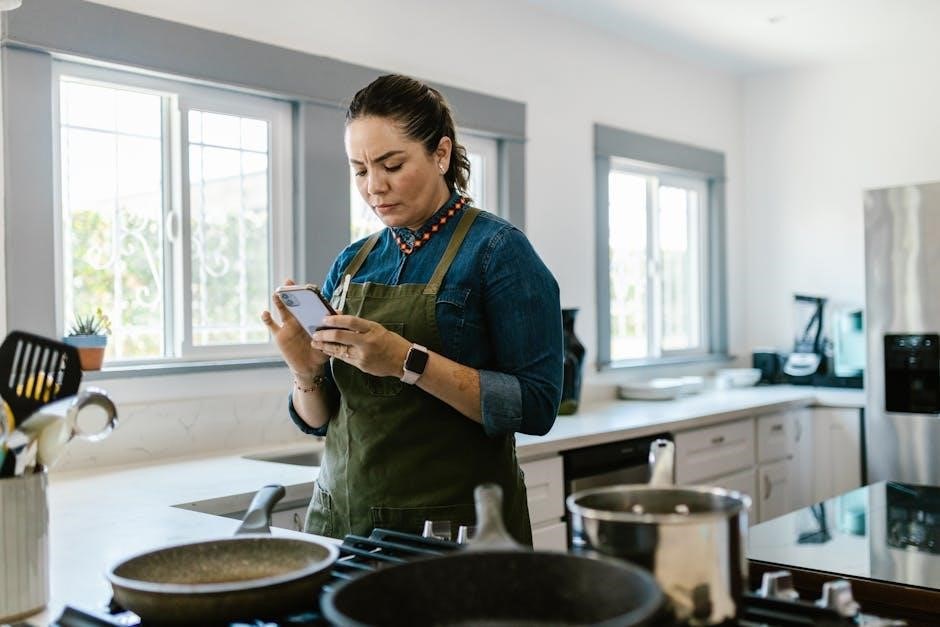Sous vide cooking offers precise temperature control for consistent results․ The Instant Pot integrates this functionality seamlessly‚ allowing home cooks to achieve restaurant-quality dishes effortlessly․ This method ensures perfect doneness every time‚ making it ideal for various proteins and vegetables․ With the Instant Pot‚ sous vide becomes accessible and user-friendly‚ enhancing your culinary creativity․
1․1 What is Sous Vide Cooking?
Sous vide cooking is a precise method where food sealed in airtight bags is cooked in a water bath at a controlled temperature․ This technique ensures even cooking and retains flavors and nutrients; The water is heated to a specific temperature‚ and the food cooks uniformly throughout․ Sous vide is ideal for delicate dishes‚ as it prevents overcooking and locks in moisture․ Its popularity has grown due to its simplicity and ability to achieve consistent‚ high-quality results for both home cooks and professional chefs․
1․2 How Instant Pot Integrates Sous Vide Functionality
The Instant Pot incorporates sous vide cooking through a dedicated mode‚ offering precise temperature control between 104°F and 190°F․ This function allows users to achieve professional-grade results by maintaining consistent water bath temperatures․ The Instant Pot’s interface simplifies the process‚ enabling easy selection of time and temperature parameters․ The device also ensures even heat distribution‚ making it ideal for delicate proteins and vegetables․ This integration brings sous vide cooking to a wider audience‚ offering a user-friendly alternative to standalone sous vide machines while delivering the same high-quality results․
Preparing for Sous Vide Cooking with Instant Pot
Before cooking‚ gather essentials like food-safe bags and a vacuum sealer․ Fill the inner pot halfway with water‚ then select Sous Vide mode and set temperature․ Ensure the lid is secure and preheat water for consistent results․ Proper preparation ensures a smooth‚ efficient sous vide experience with the Instant Pot․
2․1 Gathering Necessary Equipment
To begin‚ you’ll need the Instant Pot inner pot‚ water‚ food-safe bags‚ and a vacuum sealer․ Fill the inner pot halfway with water‚ ensuring it doesn’t exceed the max line․ Food-safe bags are essential for holding your ingredients‚ while the vacuum sealer removes air to prevent floating․ Preheating the water beforehand ensures consistent temperature control․ Selecting the Sous Vide mode and setting the desired temperature and time completes the preparation․ These steps ensure a smooth start to your sous vide cooking experience with the Instant Pot․
2․2 Understanding Water Levels and Preheating
Fill the Instant Pot inner pot halfway with water‚ ensuring it doesn’t exceed the maximum fill line․ Preheating the water is crucial for maintaining precise temperatures during sous vide cooking․ Without preheating‚ the machine may struggle to reach the set temperature‚ affecting cooking consistency․ Overfilling can lead to improper sealing‚ while underfilling may cause the water level to drop below the food․ Preheating ensures the water starts at the target temperature‚ guaranteeing accurate and even cooking results for your sous vide dishes․

Step-by-Step Setup for Sous Vide Cooking
Start by filling the Instant Pot inner pot with water to the recommended level․ Select the Sous Vide mode and set your desired temperature and time․ Secure the lid properly to ensure even heating and circulation․ This setup ensures precise temperature control for consistent cooking results‚ making the process straightforward and efficient for achieving perfect sous vide dishes every time․
3․1 Filling the Inner Pot with Water
For sous vide cooking‚ fill the Instant Pot inner pot with water to the halfway mark or approximately 10 cups for a 6QT model․ Ensure the water level is below the max line to avoid overflow․ This step is crucial for maintaining consistent temperature and circulation․ Always use cold water for precise temperature control‚ as it heats evenly․ Proper water level ensures the food is fully submerged‚ promoting uniform cooking․ Avoid overfilling‚ as this can lead to splashing or inaccurate temperature readings during the sous vide process․
3․2 Selecting Sous Vide Mode and Setting Parameters
To begin‚ access the Sous Vide mode via the Instant Pot’s control panel․ Use the dial or buttons to set your desired temperature and cooking time․ The temperature range typically spans from 100°F to 190°F (38°C to 88°C)․ Input the precise time needed for your recipe‚ ensuring it aligns with the food’s thickness and your desired doneness․ Once set‚ press Start to initiate the preheating cycle․ The device will maintain the selected temperature accurately‚ ensuring consistent cooking results․ Always refer to the manufacturer’s guidelines for specific parameter ranges and recommendations․
3․3 Securing the Lid for Sous Vide Cooking
Once your Instant Pot is preheated and the food is placed in the water bath‚ secure the lid properly․ Ensure the lid is aligned correctly and twisted until it clicks into place․ This step is crucial to maintain the water level and temperature consistency․ Avoid over-tightening‚ as this could damage the sealing ring․ If using the pressure cook lid‚ make sure the valve is set to sealing․ For sous vide mode‚ the lid does not need to be fully sealed but should remain closed to retain heat․ Always handle the lid with care‚ as it may be hot during operation․

The Sous Vide Cooking Process
The sous vide cooking process begins with initiating the cycle․ Monitor water levels and temperature closely to ensure accuracy․ This method guarantees even cooking and perfect results․
4․1 Initiating the Cooking Cycle
Once the water and food are prepared‚ press the Start button to initiate the sous vide cycle․ Ensure the lid is securely locked to maintain precise temperature control․ The Instant Pot will begin heating the water to the set temperature and circulate it evenly․ Preheating is crucial for accurate results․ Once the target temperature is reached‚ the machine will stabilize and begin the cooking process․ This step ensures your dish cooks uniformly‚ achieving the desired texture and flavor effortlessly․
4․2 Monitoring Water Levels and Temperature
Regularly check the water level to ensure it remains above the minimum mark․ The Instant Pot will alert you if water levels drop too low․ Maintain the set temperature throughout the cooking cycle for consistent results․ Avoid opening the lid excessively‚ as this can disrupt temperature stability․ Use the digital display to monitor progress and ensure accuracy․ Proper monitoring prevents overheating or undercooking‚ guaranteeing your dish turns out perfectly․ This step is crucial for achieving the desired texture and flavor in sous vide cooking․
4․3 Ensuring Accurate Temperature Maintenance
To maintain precise temperature control‚ preheat the water to the target temperature before starting․ Use the Instant Pot’s digital controls to set the exact desired temperature․ Avoid overcrowding the pot‚ as this can disrupt water circulation․ Keep the lid securely closed during cooking to prevent heat loss․ If using a delay start‚ ensure the water reaches the set temperature before adding food․ Periodically check the temperature display to confirm stability․ This ensures consistent cooking results and prevents overcooking or undercooking your dish․ Adhere to the manufacturer’s guidelines for optimal performance․
Post-Cooking Procedures
After sous vide cooking‚ pat dry the food to prepare for searing․ Sear in a pan or with a torch for a crispy finish‚ enhancing flavor and texture․
5․1 Finishing Touches and Searing
After sous vide cooking‚ remove the food from the bag and pat it dry with paper towels to ensure even browning․ For a crispy finish‚ sear the food in a hot skillet with oil or butter‚ or use a blowtorch for precision․ This step adds texture and enhances flavor․ Lightly season or add marinades before searing for extra depth․ Avoid overcrowding the pan‚ and cook until a golden-brown crust forms․ Rest the food briefly before serving to retain juices and achieve the best results․
5․2 Safely Removing Food from the Bag
Once the sous vide cycle is complete‚ carefully remove the food bag from the water bath using tongs or gloves to protect your hands from heat․ Open the bag gently to avoid spilling liquids․ Use a slotted spoon or utensils to lift the food onto a clean surface․ Pat the food dry with paper towels to remove excess moisture‚ ensuring better searing or finishing․ Be cautious of hot liquids and handle the food delicately to maintain its integrity and texture․
Common Mistakes to Avoid
Avoid overfilling the inner pot‚ as this can disrupt water circulation․ Not preheating the water or ignoring water levels and temperature can lead to uneven cooking results․
6․1 Overfilling the Inner Pot
Overfilling the inner pot can interfere with water circulation and temperature distribution‚ leading to uneven cooking․ It may also cause water to spill during cooking․ For optimal results‚ fill the inner pot no more than halfway or to the recommended 10-cup line for 6QT models․ Exceeding this level can disrupt the sous vide process and potentially damage the appliance․ Always adhere to the manufacturer’s guidelines to ensure proper function and safety during cooking․ Proper water levels are crucial for consistent and accurate sous vide results․
6․2 Not Preheating the Water
Not preheating the water before starting the sous vide process can lead to inconsistent cooking results․ Preheating ensures the water reaches the desired temperature quickly‚ preventing undercooked or overcooked food․ Without preheating‚ the appliance may take longer to stabilize the temperature‚ potentially affecting the final outcome․ Always preheat the water to the target temperature before placing the food in the sous vide bath for precise and consistent results․ This step is essential for achieving the best cooking performance with your Instant Pot sous vide function․
6․3 Ignoring Water Level and Temperature
Ignoring water level and temperature is a common mistake that can disrupt the sous vide process; The water level must be sufficient to cover the food and submerge the heating element․ If the water is too low‚ the appliance may overheat or fail to maintain the set temperature․ Similarly‚ neglecting to monitor the temperature can lead to uneven cooking or undercooked food․ Always ensure the water level is appropriate and the temperature is accurately set before starting the sous vide cycle for consistent and safe cooking results․
Cleaning and Maintenance
Regularly clean the inner pot and lid with mild soap and water․ Dry thoroughly after use to prevent rust․ Avoid abrasive cleaners to maintain finish․
7․1 Cleaning the Inner Pot and Lid
Regular cleaning is essential to maintain your Instant Pot’s performance․ After sous vide cooking‚ rinse the inner pot and lid with warm water․ Use a soft sponge and mild soap to remove any food residue․ Avoid abrasive cleaners or scourers‚ as they may damage the finish․ Dry thoroughly with a soft cloth to prevent water spots․ For tough stains‚ soak the pot in warm soapy water before scrubbing gently․ Cleaning after each use ensures hygiene and prevents leftover flavors from affecting future dishes․
7․2 Drying the Instant Pot After Use
Drying your Instant Pot after sous vide cooking is crucial to prevent rust and bacterial growth․ After cleaning‚ use a soft‚ dry cloth to thoroughly wipe the inner pot‚ lid‚ and other components․ Pay extra attention to crevices and seals‚ where moisture often accumulates․ Avoid using chemical cleaners‚ as they may damage the finish․ Ensure all parts are completely dry before storing to maintain hygiene and longevity․ Regular drying helps preserve the Instant Pot’s performance and appearance for future use․

Safety Precautions
Always handle hot components with care‚ keep children away‚ and place the pot on a heat-resistant surface․ Follow manufacturer guidelines to ensure safe operation and avoid accidents;
8․1 Handling Hot Water and Food
When handling hot water or food during sous vide cooking‚ use oven mitts or tongs to prevent burns․ Always allow food to cool slightly before handling․ Ensure the Instant Pot is placed on a heat-resistant surface․ Never touch the inner pot or lid without protection‚ as they can be extremely hot․ Use caution when releasing steam or handling hot water․ Proper handling ensures a safe and enjoyable cooking experience with your Instant Pot․
8․2 Keeping Children Away
Always keep children at a safe distance while using the Instant Pot for sous vide cooking․ The device and surrounding area can become extremely hot‚ posing a burn hazard․ Ensure the pot is placed out of children’s reach to prevent accidental touching or spills․ Supervise children in the kitchen and teach them about the dangers of hot appliances․ This precaution ensures a safe cooking environment and protects your family from potential accidents․
8․3 Placing the Pot on a Heat-Resistant Surface
Always position the Instant Pot on a heat-resistant surface to prevent damage or burns․ Avoid placing it directly on wood‚ plastic‚ or countertops that may melt or discolor․ Use a trivet‚ silicone mat‚ or ceramic tile to protect your surface․ This ensures safe operation and prevents accidental heat transfer․ The sous vide function maintains precise temperatures‚ so a heat-resistant surface is crucial during cooking․ Ensure the area is level and stable for even water circulation and optimal performance․ Always refer to the manufacturer’s guidelines for recommended surfaces․
8․4 Following Manufacturer Guidelines
Adhering to the manufacturer’s instructions ensures safe and effective use of the Instant Pot sous vide function․ Always follow guidelines for water levels‚ temperature settings‚ and lid usage․ Use only recommended accessories and avoid unauthorized modifications․ Regularly clean and maintain the pot as per instructions to prevent damage․ Refer to the user manual for troubleshooting common issues and optimal performance․ Following these guidelines ensures longevity‚ safety‚ and consistent results when using the Instant Pot for sous vide cooking․ Proper usage also maintains the warranty and prevents potential hazards․
Advanced Techniques for Enhanced Cooking
Use delayed start for meal planning‚ sear meats before sous vide for texture‚ and season generously for flavor enhancement․ These techniques elevate your sous vide results․
9․1 Using Delayed Start for Meal Planning
The delayed start feature allows you to schedule sous vide cooking in advance‚ ensuring your meal is ready when you want it․ Simply fill the Instant Pot with water‚ set your desired temperature and cooking time‚ and select the delayed start option․ This feature is ideal for busy schedules‚ enabling you to prepare ingredients in the morning and come home to perfectly cooked food․ It adds convenience and flexibility to your meal planning‚ making sous vide cooking fit seamlessly into your daily routine․
9․2 Searing Before Sous Vide
Searing before sous vide enhances flavor and texture by creating a crust on the food․ Use the Instant Pot’s sauté function to quickly sear meat or fish in a hot pan with oil; Season the food generously before searing for added flavor․ While optional‚ this step adds a caramelized exterior‚ complementing the even cooking of sous vide․ It’s a great way to combine traditional cooking techniques with modern precision for a gourmet finish․
9․3 Seasoning Food Before Sous Vide
Seasoning your food before sous vide cooking is essential for enhancing flavor․ Apply salt‚ pepper‚ herbs‚ or marinades directly to the food‚ ensuring even distribution․ For delicate flavors‚ mix seasonings into a marinade or rub․ Acidic ingredients like lemon or vinegar can be added to the bag for infusion․ Seasoning beforehand allows flavors to penetrate deeply during the sous vide process․ For bold results‚ finish with a sear after cooking to intensify the seasoning and texture‚ creating a perfectly balanced dish․

Recipe Ideas and Applications
Explore delicious Sous Vide Steak‚ perfectly cooked Sous Vide Eggs‚ tender Sous Vide Chicken Breast‚ and flavorful Sous Vide Fish Recipes with your Instant Pot for gourmet meals at home․
- Sous Vide Steak for a perfect sear and doneness․
- Sous Vide Eggs for creamy‚ consistent results․
- Sous Vide Chicken Breast for juicy‚ tender meat․
- Sous Vide Fish Recipes for flaky‚ evenly cooked fish․
10․1 Sous Vide Steak with Instant Pot
Achieve a perfectly cooked steak using your Instant Pot’s sous vide function․ Fill the inner pot with water to the recommended level‚ set the temperature between 120°F-140°F‚ and cook for 1-3 hours․ Season the steak generously before sealing it in a bag․ For a crispy crust‚ sear the steak in a hot pan before or after sous vide cooking․ This method ensures a tender‚ evenly cooked steak with precise doneness‚ making it a standout dish for any occasion․
10․2 Perfect Sous Vide Eggs
Experience the simplicity of cooking perfect sous vide eggs with your Instant Pot․ Fill the inner pot halfway with water‚ set the temperature to 145°F‚ and cook for 45-60 minutes․ Crack eggs directly into a bag or a mold for consistent results․ Season with salt‚ pepper‚ and herbs before cooking․ For a runny yolk‚ cook for 45 minutes; for firmer eggs‚ extend the time․ Finish by searing in a pan for a crispy texture․ This method ensures evenly cooked‚ creamy eggs with minimal effort‚ perfect for breakfast or brunch․
10․3 Sous Vide Chicken Breast
Cooking chicken breast to perfection is effortless with the Instant Pot sous vide function․ Season the chicken generously with your favorite spices and place it in a sealed bag․ Set the sous vide temperature to 140°F for medium-rare or 150°F for well-done․ Cook for 1-2 hours‚ depending on thickness․ After cooking‚ sear the chicken in a hot pan for a crispy exterior․ This method ensures juicy‚ evenly cooked meat with minimal effort‚ making it a staple for any meal prep or special occasion․
10․4 Sous Vide Fish Recipes
Cooking fish sous vide with the Instant Pot ensures tender‚ evenly cooked results․ Delicate fish like salmon‚ cod‚ and tilapia thrive in this precise temperature-controlled environment․ Marinate the fish beforehand for enhanced flavor‚ then seal it in a bag․ Set the sous vide temperature between 120°F and 140°F‚ depending on the fish type‚ and cook for 30-45 minutes․ Finish with a quick sear for a crispy texture․ This method prevents overcooking‚ making it ideal for achieving perfectly cooked‚ moist fish every time․

Troubleshooting Common Issues
Addressing issues like inaccurate temperatures or uneven cooking ensures optimal results․ Check water levels‚ verify sealing‚ and maintain proper sous vide settings for consistent outcomes․
11․1 Dealing with Inaccurate Temperatures
Inaccurate temperatures can affect sous vide results․ Ensure the water level is correct and avoid overfilling‚ as this may disrupt temperature control․ Preheating the water to the target temperature before starting can help maintain consistency․ Use a reliable thermometer to verify accuracy․ If issues persist‚ calibrate your Instant Pot’s temperature settings or consult the user manual for troubleshooting steps․ Proper lid sealing is also crucial for precise temperature maintenance during cooking․
11․2 Addressing Uneven Cooking
Uneven cooking can occur if water circulation is inadequate or food isn’t properly sealed․ Ensure the Instant Pot is filled with enough water to cover the food bag without overfilling․ Gently agitate the water during cooking to promote even heat distribution․ Verify that the food is evenly portioned and sealed tightly to prevent cold spots․ If issues persist‚ adjust the cooking time or temperature slightly․ Proper water level maintenance and lid sealing are key to achieving consistent results in sous vide cooking․
11․3 Solving Food Bag Sealing Issues
Sealing problems can prevent proper sous vide cooking․ Ensure food bags are airtight by removing all air before sealing․ Use high-quality‚ food-safe bags designed for sous vide․ If air pockets form‚ gently press the bag to eliminate them․ For extra security‚ use a vacuum sealer or the water displacement method․ Avoid overfilling bags‚ as this can hinder sealing․ Always submerge the bag fully in water to maintain even cooking․ Proper sealing prevents leaks and ensures consistent results in your Instant Pot sous vide setup․
Mastering sous vide with your Instant Pot is now effortless․ This guide provides detailed instructions from setup to advanced techniques‚ ensuring perfect results․ Explore recommended recipes and resources for continuous culinary innovation․
12․1 Summary of Instant Pot Sous Vide Benefits
The Instant Pot’s sous vide functionality offers unparalleled precision and convenience‚ ensuring perfectly cooked meals․ It eliminates the need for separate devices‚ combining multiple cooking methods in one appliance․ With accurate temperature control‚ it delivers consistent results for proteins‚ eggs‚ and vegetables․ The hands-off process allows for effortless meal preparation‚ while the ability to delay start adds flexibility․ Whether you’re a novice or an experienced cook‚ the Instant Pot’s sous vide feature simplifies achieving restaurant-quality dishes at home‚ making it a versatile and indispensable kitchen tool․
12․2 Recommended Reading and Courses
Enhance your sous vide skills with resources like The Sous Vide Bible and Mastering Sous Vide Cooking․ Online platforms such as Udemy and Coursera offer detailed courses on sous vide techniques․ Websites like Serious Eats and ChefSteps provide step-by-step guides and troubleshooting tips․ For Instant Pot-specific guidance‚ explore the official user manuals and forums․ These resources will help you master sous vide cooking‚ from basic to advanced methods‚ ensuring you get the most out of your Instant Pot’s capabilities․ Continuous learning will expand your culinary creativity and precision․
